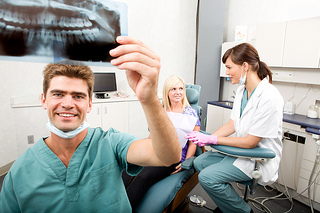September 20th, 2023

Getting your child excited about braces is a lot like: A) convincing a grumpy toddler that it’s time to take a nap? B) convincing a teenager to stop texting during dinner? C) convincing your husband to eat his peas? The answer, obviously, is all of the above.
And that’s why you may need a few thoughtful ways to get your child on board with braces.
- Throw a pre-braces party. It can’t be just any party, however, but a Willy Wonka celebration of candy, chips, gum, and all the sticky and sweet foods your child won’t be able to indulge in during the time he or she is wearing braces. Promise a post-braces celebration, too, and watch as your child’s eyes widen at the thought of an all-you-can-eat junk food buffet.
- Encouraging phrases like “braces aren’t eternal, but your straight smile will be” can go a long way.
- If your daughter is worried about getting picked on because of braces, then name-drop some A-list celebrities who have worn them. The list includes Cameron Diaz, Kelly Clarkson, Dakota Fanning, and Gwen Stefani.
- Emphasize that braces today aren’t the same as they were in the Stone Age. From clear ceramic braces to different-colored braces, more options are available. Braces can be cool accessories to express a personal style.
- To get your child to embrace braces, you need to sing the praises of beautiful teeth, even if that means pointing out how crooked your teeth are because you never got braces.
September 20th, 2023

The average age of individuals who get braces is between nine and 14, although it is appropriate for younger children to visit Bauer Hite Orthodontic Specialists for a consultation with Dr. Elizabeth Hite, DMD, MS. While parents may be concerned about the efficacy of early orthodontics, research suggests that early intervention can prevent greater dental health problems later in life.
What types of conditions require early intervention?
According to the American Association of Orthodontists, 3.7 million children under the age of 17 receive orthodontic treatment each year. Early intervention may be appropriate for younger children with crooked teeth, jaw misalignment, and other common issues. Early orthodontic treatment may be of use for several types of problems:
- Class I malocclusion. This condition is very common. It features crooked teeth or those that protrude at abnormal angles. In general, early treatment for Class I malocclusion occurs in two phases, each two years long.
- Class III malocclusion. Known as an underbite, in which the lower jaw is too big or the upper jaw too small, Class III malocclusion requires early intervention. Because treatment involves changing growth patterns, starting as early as age seven is a smart choice for this dental problem.
- Crossbite. Crossbite occurs when the upper and lower jaws are not properly aligned. An orthodontic device called a palatal expander widens the upper jaw, allowing teeth to align properly. Research suggests that early treatment may be beneficial in crossbite cases, especially when the jaw must shift laterally to correct the problem.
- Tooth extraction. That mouthful of crooked baby teeth can cause problems when your child’s permanent teeth erupt. For kids with especially full mouths, extracting baby teeth and even permanent premolars can help adult teeth grow in straight.
Considerations when thinking about early intervention
Early intervention isn’t helpful for all conditions. For example, research suggests that there is little benefit to early orthodontics for Class II malocclusion (commonly known as an overbite). Instead, your child should wait until adolescence to begin treatment. Scheduling a visit to our Edwardsville office when your child is around age seven is a smart way to create an individualized treatment plan that addresses unique orthodontic needs.
September 13th, 2023

Two-phase orthodontic treatment involves two separate and distinct periods that your child receives orthodontic treatment. It allows your son or daughter to begin early treatment of bite and jaw problems, in order to reduce the dental issues he or she experiences later on.
Two-phase orthodontic treatment with Dr. Elizabeth Hite, DMD, MS can improve how well the second phase of the treatment works and helps to make room for permanent teeth. Overall, two-phase treatment helps to position the teeth and the jaw for an attractive profile. Our team at Bauer Hite Orthodontic Specialists recommends that you bring your child to our Edwardsville office at the age of seven or eight, so that Dr. Elizabeth Hite, DMD, MS can determine if early (Phase-One) treatment is necessary.
Phase-One
Phase-One orthodontic treatment is known as early treatment. It begins shortly after your child’s first orthodontic examination, usually around age eight or nine. The main goal of Phase-One orthodontic treatment is to help make room for permanent teeth, which reduces crooked teeth as a result of overcrowding. It treats the jaw and bite growth, and issues like crossbite or underbite. This can reduce the need for your child to undergo extractions.
Phase-Two
Phase-Two orthodontic treatment is when braces are placed on the upper and/or lower teeth. The purpose is not just to correct spaces or misaligned teeth, but also to correct overbite or underbite concerns. Phase-Two usually begins around age 11 or 12, and the braces are worn for an average of two to three years, depending on your child’s unique needs. Some children have fewer issues and wear braces for little more than a year, while others need them for up to four years.
Signs your child needs two-phase orthodontic treatment
If your child exhibits the following signs, he or she may be a good candidate for two-phase orthodontic treatment:
- Losing baby teeth early, before five years of age
- Problems with biting or chewing
- Sucking the thumb after age five
- Evidence of a crossbite, where the teeth don’t come together when opening or closing of the mouth
- Teeth are crowded at age seven or eight
- Protruding teeth on the top or bottom
Not all children need to have early treatment, but if your child shows any of these signs, you should bring him or her to us for an evaluation at Bauer Hite Orthodontic Specialists.
September 13th, 2023

Orthognathic surgery is surgery to correct a wide variety of abnormalities of our patients' jaw and teeth. The surgery is often done in conjunction with orthodontic treatment. While the patient’s appearance may be significantly improved as a result, the primary purpose of the surgery is to correct functional problems including but not limited to:
- Unbalanced facial appearance
- Protruding jaw
- Open bite (upper and lower teeth don’t overlap properly
- Excessive wearing down of the teeth
- Difficulty with chewing or biting
- Chronic mouth breathing
- Sleeping problems such as sleep apnea
- TMJ pain (jaw joint pain)
- Restoring facial injuries
Knowing when to start the orthodontic treatment in preparation for orthognathic surgery can also be tricky if our team at Bauer Hite Orthodontic Specialists is treating a teenager. It is important to know when to get started. If orthodontic treatment is initiated too soon and the teenager is still growing, the patient will either need to hold in braces until his or her growth is complete and they are ready for surgery or the braces will have to be removed and then placed again when growth is complete. Neither of these options is attractive since it requires longer time in treatment, which is something all our patients want to avoid. Our team at Bauer Hite Orthodontic Specialists strives to get all patients finished with treatment as quickly as possible because it is healthier for the teeth and gums and gives them a beautiful smile to enjoy for a lifetime.
If you are considering orthognathic surgery or you have been told that you need jaw surgery, give us a call to schedule your initial consultation today. Dr. Elizabeth Hite, DMD, MS and our team at Bauer Hite Orthodontic Specialists will explain our treatment plan in a way you will understand and we will keep you informed every step of the way.







 Website Powered by Sesame 24-7™
Website Powered by Sesame 24-7™